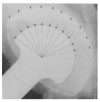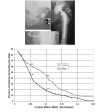Clinical biomechanics of wear in total hip arthroplasty
- PMID: 14575243
- PMCID: PMC1888402
Clinical biomechanics of wear in total hip arthroplasty
Abstract
Complementary clinical and laboratory studies were performed to identify variables associated with polyethylene wear following total hip replacement, and to elucidate the mechanisms responsible for accelerated wear in the total hip arthroplasty construct. Observational cohort studies were performed using a prospective clinical database of more than 4000 consecutive primary total hip arthroplasties performed by a single surgeon, to identify wear-related variables. These variables included head size, acetabular/femoral component impingement, and third body debris. Novel digital edge detection techniques were developed and employed to accurately measure wear, and to determine the relationships of head size and third body debris to acceleration of wear. A novel sliding-distance-coupled finite element model was formulated and employed to examine the mechanisms responsible for wear. The long-term cohort studies demonstrated smaller head sizes to be associated with less wear. Third body debris generated from cable fretting was associated with an increase in wear, osteolysis, and acetabular loosening, especially with larger head sizes. The sliding-distance-coupled finite element model replicated the wear rates occurring in vitro and in vivo, demonstrating the importance of sliding distance on polyethylene wear following total hip arthroplasty. It also demonstrated substantial increases in wear associated with femoral head scratching from third body debris. Further extension of the finite element formulation demonstrated the potential for acetabular component rim damage from impingement wear, and the enhanced potential for third body ingress to the bearing surface with larger head sizes. Edge detection wear measurement techniques demonstrated that early wear rates were predictive of long-term wear rates. These complementary clinical and laboratory investigations have provided insight into 1) the significance of sliding distance and physiologic loci of motion as contributing factors in minimizing wear, 2) the deleterious effects of third body particulates in accelerating wear, 3) the potential for, and factors related to, impingement wear, and 4) the potential advantages and compromises related to the use of larger head sizes in the bearing surface construct.
Figures
















Similar articles
-
Finite element simulation of early creep and wear in total hip arthroplasty.J Biomech. 2005 Dec;38(12):2365-74. doi: 10.1016/j.jbiomech.2004.10.022. Epub 2004 Dec 13. J Biomech. 2005. PMID: 16214484
-
Problematic sites of third body embedment in polyethylene for total hip wear acceleration.J Biomech. 2006;39(7):1208-16. doi: 10.1016/j.jbiomech.2005.03.014. J Biomech. 2006. PMID: 15894322
-
Polyethylene wear and acetabular component orientation.J Bone Joint Surg Am. 2003;85-A Suppl 4:56-63. doi: 10.2106/00004623-200300004-00007. J Bone Joint Surg Am. 2003. PMID: 14652394
-
Metallosis after metal-on-polyethylene total hip arthroplasty.Am J Orthop (Belle Mead NJ). 2008 Feb;37(2):E18-25. Am J Orthop (Belle Mead NJ). 2008. PMID: 18401490 Review.
-
Radiographic methods for the assessment of polyethylene wear after total hip arthroplasty.J Bone Joint Surg Am. 2005 Oct;87(10):2323-34. doi: 10.2106/JBJS.E.00223. J Bone Joint Surg Am. 2005. PMID: 16203901 Review.
Cited by
-
MyHip: supporting planning and surgical guidance for a better total hip arthroplasty : A pilot study.Int J Comput Assist Radiol Surg. 2015 Oct;10(10):1547-56. doi: 10.1007/s11548-015-1177-2. Epub 2015 Apr 1. Int J Comput Assist Radiol Surg. 2015. PMID: 25877209
-
Metallosis following full thickness wear in total hip arthroplasty.J Surg Case Rep. 2015 Sep 22;2015(9):rjv122. doi: 10.1093/jscr/rjv122. J Surg Case Rep. 2015. PMID: 26395872 Free PMC article.
-
Hip Joint Angles and Moments during Stair Ascent Using Neural Networks and Wearable Sensors.Bioengineering (Basel). 2023 Jun 30;10(7):784. doi: 10.3390/bioengineering10070784. Bioengineering (Basel). 2023. PMID: 37508811 Free PMC article.
References
-
- Archard JF. Contact and Rubbing of Flat Surfaces. J Appl Phys. 1953;24:981–988.
-
- Ash SA, Callaghan JJ, Johnston RC. Revision Total Hip Arthroplasty with Cement after Cup Arthroplasty -Long-Term Follow-Up. J Bone Joint Surg. (Am) 1996;78:87–93. - PubMed
-
- Ballard WT, Callaghan JJ, Sullivan PM, Johnston RC. The Results of Improved Cementing Techniques for Total Hip Arthroplasty in Patients Less Than Fifty Years Old. A Ten-Year Follow-Up Study. J Bone Joint Surg. (Am) 1994;76:959–964. - PubMed
-
- Barrack RL, Burke DW, Cook SD, Skinner HB, Harris WH. Complications Related to Modularity of Total Hip Components. J Bone Joint Surg. (Br) 1993;75:688–692. - PubMed
-
- Bono JV, Sanford L, Toussaint JT. Severe Polyethylene Wear in Total Hip Arthroplasty. Observations from Retrieved AML PLUS Hip Implants with an ACS Polyethylene Liner. J Arthroplasty. 1994;9:119–125. - PubMed
Publication types
MeSH terms
Substances
LinkOut - more resources
Full Text Sources
Medical
